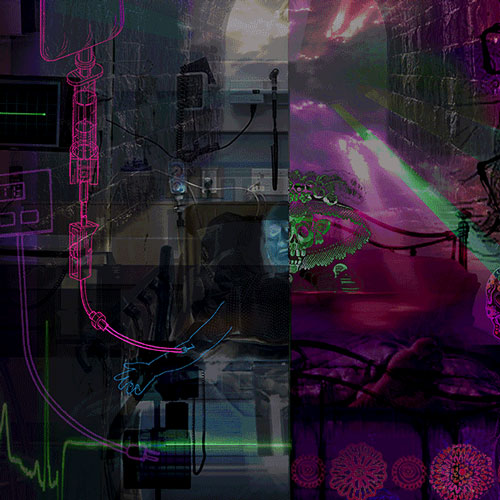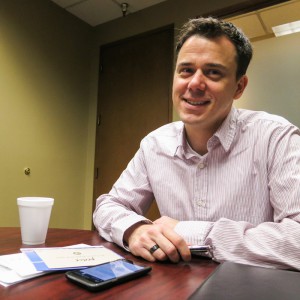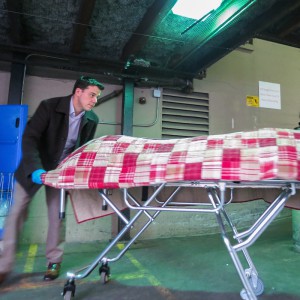
Americans don’t seem to have much trouble with violent death at the movies. But real death is a different story. Slow, lingering death from old age, funerals, embalming, cremation – these are not really dinner table conversation. A group called The Order of the Good Death is trying to change that. The Order wants to “prepare a death-phobic culture for their inevitable mortality.” Producer Catherine Winter spent some time with members of the Order in Seattle, and rode with a dead woman on her last trip, to the crematorium.
By Catherine Winter
I don’t think I’m morbid, but I do think about death. I’ve been thinking for years that when my loved one dies, I don’t want to hand him over to a funeral home. I don’t want anyone messing with his body who doesn’t realize how awesome he is. I want him to be well loved until he’s ashes, and even after that.
Until recently, I hadn’t told anyone I was thinking about this. I didn’t want friends to think I’m creepy. Death isn’t generally welcome at the dinner table.
But death is starting to have a much busier social life. Death is getting invited to parties. It has web sites and Twitter feeds. Death is even sort of hip among some people in a surprisingly young crowd, 30-somethings who are not likely to face their own death any time soon.
There are death salons and death cafes. There’s a project called Let’s Have Dinner and Talk about Death. There’s a group called The Order of the Good Death, whose members include writers, artists, historians, morticians, a medical librarian, and even a “death midwife,” who will help you do home death care.
“Just like we had the home birth movement in the ’70s,” says writer Bess Lovejoy, a member of the Order of the Good Death, “there’s starting to be more people dying at home, home funerals, taking care of the dead at home.”
Mortician Jeff Jorgenson agrees.
“People used to care for their dead,” he says. “People are starting to realize that they can care for their dead.”
Jorgenson is a member of the Order of the Good Death and the owner of Elemental Cremation and Burial, which bills itself as Seattle’s only green funeral home.
He says he tries to let families take over as much of the process of caring for dead people and holding funerals as they are comfortable doing. Recently, he worked with a family that had a funeral for their mother in her home.
“Just through the entryway was her dining room table, and the dining room table was actually the perfect spot for her,” Jorgenson says. “So we just put her there.”
Jorgenson says he wishes that happened all the time.
“Because that’s a family that’s embracing it,” he says. “They’re creating a ritual for themselves. That is magical.”
Jorgenson says that family even drove the body to the cemetery themselves. But most people don’t want to do that. Many people don’t realize it’s even an option. Jorgenson gets a lot of questions about what you can legally do with a dead body.
Like, do you have to have the body embalmed?
“No you don’t need to embalm anyone,” he says. “I don’t know of a jurisdiction in this country where it is legally required — under most circumstances.”
He’s also been asked whether you can flush cremated remains down the toilet. Not a good idea, he explains on his web site:
The human remains are more sizable than you may think, and are not fluffy ash. If you choose to flush them, it’s likely that it will be tedious and you may incur a plumber’s bill larger than the crematory bill. From the environmental perspective, keep in mind that you are going to be flushing the toilet quite a few times.
Jorgenson says some questions come up repeatedly, like can you bury a corpse at home? (No.) And some questions come up less often, like can you send cremated remains into orbit? (Yes.)
He’s working with the founder of the Order of the Good Death, mortician Caitlin Doughty, on a video series called “Is it Legal?” In the first installment they discuss whether you can have a Viking funeral, in which you put the corpse on a boat and set it alight.
Doughty delivers the bad news: “No! It’s totally not legal because you’re not allowed to set a corpse on fire in a municipal waterway and have some random scorched foot wash up on a kid playing with his toy sailboat a week later.”
You can’t have a backyard pyre, either.
Still, there are a lot of things you can do. You can do the washing and dressing of your loved one’s corpse. You can transport the body yourself. You can be there when your loved one goes into the retort – the chamber where the body is cremated.
But Jeff Jorgenson doesn’t expect home death care to put guys like him out of business any time soon. There are parts of dealing with the dead that are difficult if you’re not a professional, like filing all the paperwork and transporting the body.
Silent companion
Jorgenson took me along with him one day when he picked up a body, an elderly woman who had died that morning after a long illness.
He has a van and a gurney – equipment most of us don’t have – and he knew where to go: the back door of the hospital, by the dumpsters and the loading dock. Live people go in the front doors of hospitals, but the dead come out the back.
He wheeled the gurney through industrial-looking hallways to the morgue. It was not at all like the big gleaming rooms you see in movies. It was small, with three slide-in coolers. A sign told hospital workers not to store their lunches in there.
A hospital worker met him there, and the two of them chatted brightly, as though he had come to deliver flowers, or pick up laundry. Then they opened a cooler and pulled the woman out.
She was zipped into a rubbery bag. Somehow the sound of that rubber being moved around, knowing what was in the bag, caused me a wave of nausea. It got worse when they zipped open the bag to make sure Jorgenson was taking the right person. The woman’s face was waxen and her hands were swollen. I had to look away while they checked the ID band on her wrist.
Jorgenson told me later than people don’t tend to look their best when they die. He also told me later that she was still warm when he moved her to his gurney, which made that nausea rise again. She was too heavy for him to move by himself, so he used a mechanical lift. He put a quilt over her, signed many pieces of paper, said a cheery goodbye to the hospital worker, and wheeled her out to the van.
As we drove away, Jorgenson was still breezy, pointing out landmarks like the Medical Examiner’s office, a trauma center, and Vital Statistics. I was still shaky, feeling the presence of the silent person lying right behind our seats.
“I’ve never been in a van with a dead person before,” I told him.
“Most people haven’t,” he pointed out.
“I find it creepy,” I admitted.
“For quite some time I thought it was creepy,” Jorgenson told me. “But it moved from creepy fairly early on to an honor. Not everyone gets to do this. I’m really lucky.”
I told Jorgenson that I had only seen one other dead person in my entire life. He was shocked.
“Really?” Jorgenson said. “That’s something that I tend to forget. People don’t see dead people.”
I said I wondered what that says about our culture. Surely in the past we weren’t so removed from death. It wasn’t so hidden.
“I think our connection to death right now is at a low point,” Jorgenson said.
He’d like people to get reacquainted with death. He said death is one “end of a life’s journey.”
“We’re very acquainted with the other end,” he said. “Everyone’s got a video camera in the birthing room. We’ve embraced birth, but I think that ultimately, in our generation, we’re embracing the notion that, yeah, we need to have more dialog about this and we need to be more involved.”
After you’re gone
Jorgenson says he thinks it’s unkind not to think about your own death, not to leave instructions for the people you leave behind. People often tell him, “I don’t care, I’m not going to be here.”
“Think about your family, for god’s sake,” he says. ”Don’t be so selfish that you put that on other people to decide. Make it a dialogue. It’s tough to be left behind.”
He knows from experience. His mother died last year. He cared for her for the last six months of her life. And he took care of her after she died.
“I told her I’d be there through the cremation, and so when it came time, I went down there,” Jorgenson says. He tears up at the memory. “And I said goodbye to her and put her into the retort and cremated her.”
He says it was really, really hard. But it was also cathartic.
“I think that in our busy lives and our lack of acceptance of death, we’ve forgotten that caring for our dead is healing,” he says. “I don’t profess that any of this is going to be fun for anyone. It’s not. Death isn’t fun. And at the same time, knowing that you’ve cared for your loved one is pretty priceless.”
The Order of the Good Death would like to inspire more people to care for their own dead. But spending a morning with Jeff actually had the opposite effect on me.
I had been thinking that if my sweetheart dies before I do, I’d want to be the one to clean him up and dress him. Now, I’m not so sure. I hadn’t really thought about how heavy a body is. And I didn’t realize how squeamish I am. After we took the dead woman to the crematorium, I was kind of shaky for the rest of the day.
But I hope Jeff will be glad to know that he made his point about making your wishes known. Just so no one has to guess what to do with me when I’m gone, here it is, for the record: Please donate any usable parts, and then cremate me. Nothing fancy, whatever’s cheapest. And please toss my ashes into Lake Superior.
I checked. It’s legal.
Get Podcast 4 — Sharing with strangers
MORE AUDIO from TRBQ:
Subscribe the to the TRBQ podcast on iTunes.
Listen to the TRBQ podcast on Stitcher.
Follow TRBQ on SoundCloud.






This was awesome. THANK YOU
Death. It’s a fact of life!
Thanks for stepping out and pushing beyond the limits of comfort. I think mentioning aging reversal and aging cessation therapy would bring attention to very big questions!
Thank you for taking the time to write this, it’s something we all should be thinking of….I am 73 years old, I know I need to be thinking of the end!!